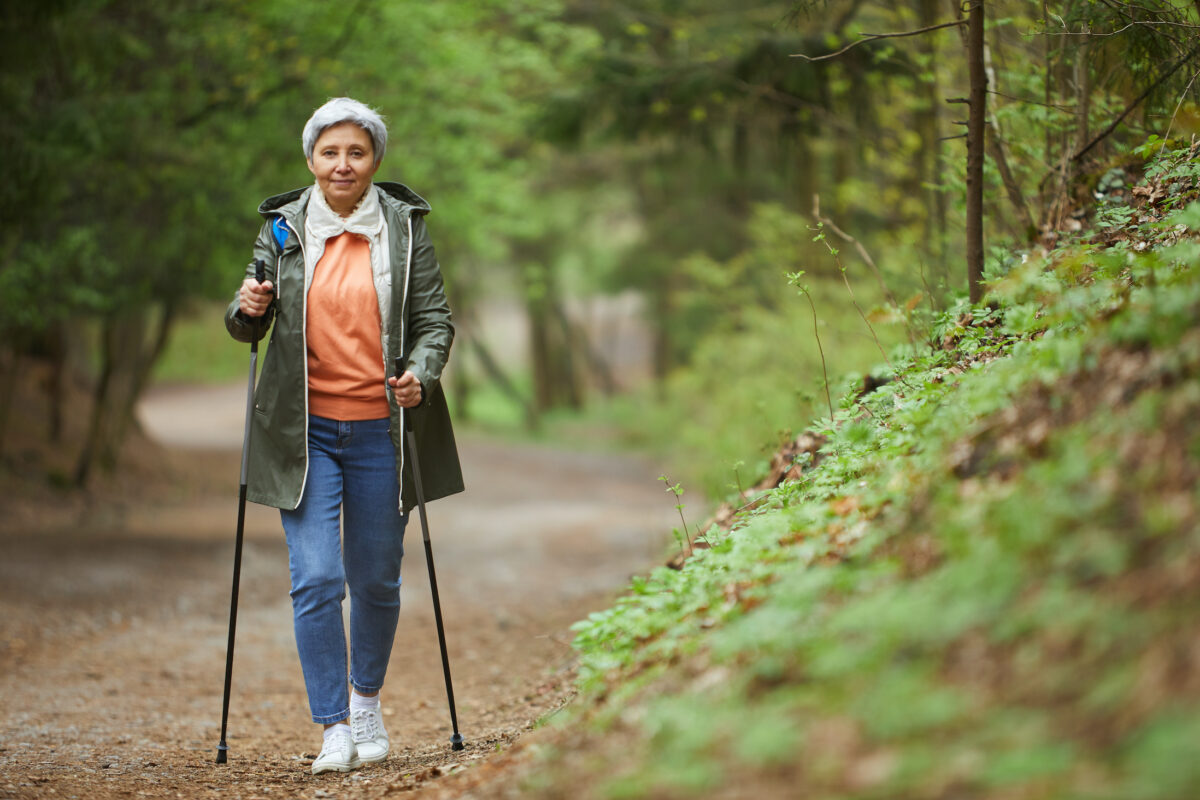
It allows you to sustain a much brisker pace. what is wrong with that? It also offsets poor shoe design which none of us can ever perfect.
so it is common elsewhere and surely better than walking canes.
They are also easy to come by.
Why You Should Try Walking With Poles
While it may be uncommon in North America, Nordic walking is a great way to get more out of your walk.(SeventyFour/Shutterstock)
Here are 7 reasons Nordic walking is better for you than the normal kind
BY LINDSAY BOTTOMS TIMEAUGUST 11, 2022 PRINT
Have you ever noticed people outside walking with poles, even on flat surfaces, and wondered why they’re doing it? This is known as Nordic walking, and it’s a little bit like cross-country skiing but without the snow.
Walking with poles was first developed in Scandinavia and came to central Europe about 20 years ago. For some reason, it hasn’t become particularly popular, even though it has many health benefits.
Here are several good reasons to give Nordic walking a try.
1. Burns More Calories
As far back as 1995, researchers noticed that Nordic walking burned more calories than regular walking did. In fact, they found it burned up to 18 percent more calories than ordinary walking did.
Numerous studies have confirmed these findings since—which is why it’s suggested that Nordic walking could be a great form of exercise for those looking to lose weight. One study from Italy even found that overweight people lost weight faster doing Nordic walking compared to ordinary walking.
While Nordic walking doesn’t burn more calories than other, more intense forms of exercise such as running, it can be a great low-impact exercise option, or a way to boost the benefits of your regular daily walks.
2. May Reduce Limb Pain
Using poles while you walk can distribute your weight through the arms and torso, placing less strain on your back, knees, and hips. In theory, this has the potential to improve back pain while walking.
However, research is mixed, with some studies showing Nordic walking can reduce lower back pain and impact on the knees, while others show it’s no more helpful than ordinary walking.
If you’re someone who suffers from lower back, hip, or knee pain, Nordic walking could be helpful to you since it redistributes your weight somewhat. But it’s worth discussing with your doctor first before giving it a try and stopping if your pain still persists even while using the poles.
3. Improves Upper Body Strength
Nordic walking engages your arms and shoulders more than regular walking does, and that could improve your strength. Research has shown that Nordic walking not only increases hand grip strength, but also increases muscle activity in the shoulders.
Upper body strength—including how strong your grip is—is important for many of the things we do every day, from carrying our grocery bags to filling up the kettle. Increasing muscle strength is also important in preventing injury, as it helps to stabilize the joints and protects them when moving under pressure, such as carrying heavy shopping bags.
4. Increases Core Strength
Nordic walking also engages the core muscles (including those in the abdomen and back) more than ordinary walking does.
Greater engagement of the core muscles will help to strengthen them, which may, in turn, improve posture. Better core strength can also improve your balance as well as your ability to move.
5. Reduces Risk of Falling
Unfortunately, as we get older we’re more likely to trip and fall when walking. This is mainly because of a decrease in muscle strength, balance issues, and problems with the way we walk.
The benefit of Nordic walking is that you are placing the poles onto the ground at the same time as you’re using your legs. This improves your balance and makes you less likely to fall.
In fact, one study even showed that people who followed a Nordic walking training program for three weeks had improved balance—even when walking without poles. It’s no wonder why Public Health England recommends Nordic walking for older people to improve their balance.
6. Boosts Cardiovascular Health
Research shows that Nordic walking can improve cardiovascular fitness in as little as four weeks.
Another study on obese women also showed Nordic walking was able to improve blood pressure, though only to a similar extent as ordinary walking. In addition, Nordic walking has been shown in postmenopausal women to improve resting blood sugar levels, which is important in preventing diabetes and improving cholesterol levels in the blood.
7. Speeds Up Your Walking Pace
Nordic walking can help you to get where you want to go faster than ordinary walking can. In fact, a review showed Nordic walking increased average walking speed by up to 25 percent as compared to ordinary walking. As a consequence of walking faster, you then burn more calories. So if you went for a 30-minute Nordic walk, you’d be able to walk farther and burn more calories than you might on a regular walk.
There seem to be clear advantages to Nordic walking. It may especially be good for people who don’t like other types of exercise—such as running—but still want to do something of a higher intensity than brisk walking.

Lindsay Bottoms is a reader in exercise and health physiology at the University of Hertfordshire in the UK. This article is republished from The Conversation.
No comments:
Post a Comment